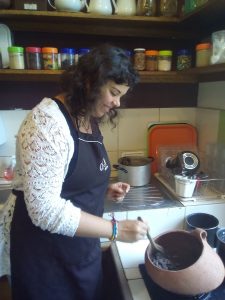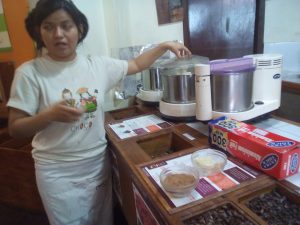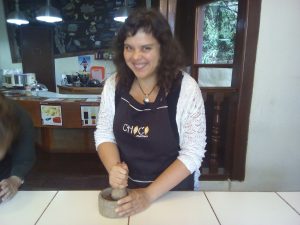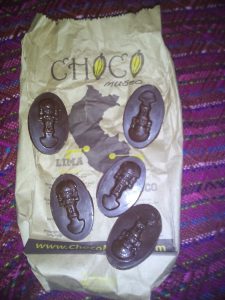My visit to the Chocolate Museum in Lima
Today I visited the Choco Museo in Lima where I participated in a chocolate making workshop. First our teacher Lucia explained us the whole process of drying and fermentation as important processes for the development of the flavor in the bean. We were able to taste the difference of chocolates made from beans of different regions. The Cacao bean has the ability to absorb tastes from the surrounding vegetation and cultivated crops. So beans that come from the north, around Piura have distinct flavors of Mango and Citrus, beans from the Amazon taste like medicinal herbs and beans from San Martin are quite pure Cacao tasting. It is surprising how different the chocolates taste and of course also depending on the type of Cacao and the thoroughness of the drying and fermentation they vary in bitterness.
The next step was to choose beans of the same size and roast them. They should have the same size, so that they roast evenly. Traditionally this is done in an earthen pot and the beans need to be slowly turned with a wooden spoon until the distinctive Cacao smell develops and the beans pop open like popcorn. The whole process is a pleasure for the senses as the flavors of the Cacao start to fill the kitchen.
 Roasting the beans (copyright N.Markiefka)
Roasting the beans (copyright N.Markiefka)
After the roasting the husk is removed. We made a sort of tea out of it by leaving it soaking in hot water. The tea has a strong earthy flavor and it contains high levels of magnesium, potassium,Vitamin D and Theobromine, a stimulant similar to caffeine which stimulates serotonin production and improves wellness.
Our teacher explained us that even though the Cacao comes from the Amazon basin it has been most popular in Central America where the Mayas and the Aztecs veneered it as a sacred plant and used it for strength, potency and ceremonies. The Cacao was so important for them that it was used as a currency. One could buy a slave for 200 beans.
After tasting the delicious tea we started grinding the dehusked beans in a mortar, in the end we obtained a paste, as we did not separate the powder from the cacao butter, which makes up 50% of the bean. In chocolate making this would happen by grinding the beans while heating it at the same time to separate the two.Then depending on the type of chocolate that is made different amounts of Cacao butter, Cacao powder, sugar and milk powder (for milk chocolate or white chocolate) are mixed together.
 Machines used to mix different chocolates, the process can take up to 24 h to obtain a smooth paste (copyright N.Markiefka)
Machines used to mix different chocolates, the process can take up to 24 h to obtain a smooth paste (copyright N.Markiefka)
We mixed some of the paste that we obtained with honey and chili (instead of blood, that was used by the Mayas!) and poured hot water on it to obtain a brown liquid. The Mayas used a second jar to pour the liquid from one into another and thus mixing all the ingredients together. I must say that the whole process had something of a ritual to it and when we tasted the Maya beverage it was incredibly savory. The chili makes a great addition to the cacao and honey. The drink also was quite strong and I could feel my blood vessels opening and my heart pumping. This is because of the Flavonols found in Cacao which lower blood pressure and improve the blood flow to the brain and heart. I can now understand why Cacao was so dear to the hard working people in the Maya and Aztec era. I could feel how it gave me strength and lid up my mood.
 Grinding the beans (copyright N.Markiefka)
Grinding the beans (copyright N.Markiefka)
The ancient civilizations of Central America were later conquered by the Spaniards and they soon discovered the commonly used beverage, but for their European palates the beverage was too bitter and they changed the recipe to make it more palatable for Europeans. So the third drink we prepared was a mix of cacao paste, cloves, cinnamon, sugar and hot milk. The hot Cacao was also delicious but much heavier due to the milk and to be honest I preferred the Maya version.
The last step in our chocolate adventure was to actually make our own chocolate. We could chose from different molds which we filled with chocolate and different ingredients such as salt, Peanuts, Coca powder, Chili, Cinnamon, Kiwicha (an ancient Andean grain), Quinoa and others. After 20 min that we used tasting different delicious Cacao liquors and marmalade our chocolates were ready to take home.
 (copyright N.Markiefka)
(copyright N.Markiefka)
What a great day, I learned so much about this amazing plant and I’m looking forward to taste all these chocolates with my friends!
Choco Museo Miraflores
Calle Berlin 375
For further reading:
Grivetti, L.E. and Shapiro, H.Y., 2011. Chocolate: history, culture, and heritage. John Wiley & Sons

